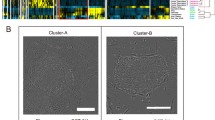Abstract
Embryonic Stem Cells (ESCs) are of great interest for providing a resource to generate useful cell types for transplantation or novel therapeutic studies. However, molecular events controlling the unique ability of ESCs to self-renew as pluripotent cells or to differentiate producing somatic progeny have not been fully elucidated yet. In this context, the Colony Forming (CF) assay provides a simple, reliable, broadly applicable, and highly specific functional assay for quantifying undifferentiated pluripotent mouse ESCs (mESCs) with self-renewal potential. In this paper, we discuss first results obtained by developing and using automatic software tools, interfacing image processing modules with machine learning algorithms, for morphological analysis and classification of digital images of mESC colonies grown under standardized assay conditions. We believe that the combined use of CF assay and the software tool should enhance future elucidation of the mechanisms that regulate mESCs propagation, metastability, and early differentiation.
Access this chapter
Tax calculation will be finalised at checkout
Purchases are for personal use only
Similar content being viewed by others
Notes
- 1.
Detailed results may be supplied on demand.
References
Bar, L., et al.: Mumford and Shah model and its applications to image segmentation and image restoration. Handbook of Mathematical Methods in Imaging, vol. I, pp. 1095–1157. Springer, New York (2011)
Breiman, L., Friedman, J., Olshen, R., Stone, C.: Classification and Regression Trees. Chapman & Hall, New York (1984)
Carpenter, A., Jones, T., Lamprecht, M., Clarke, C., Kang, I., Friman, O., Guertin, D., Chang, J., Lindquist, R., Moffat, J., Golland, P., Sabatini, D.: CellProfiler: image analysis software for identifying and quantifying cell phenotypes. Genome Biol. 7(R100) (2006)
Casalino, L., Comes, S., Lambazzi, G., De Stefano, B., Filosa, S., De Falco, S., De Cesare, D., Minchiotti, G., Patriarca, E.: Control of embryonic stem cell metastability by l-proline catabolism. J. Mol. Cell Biol. 3(2), 108– (2011)
Celebi, M., Kingravi, H., Uddin, B., Iyatomi, H., Aslandogan, Y., Stoecker, W., Moss, R.: A methodological approach to the classification of dermoscopy images. Comput. Med. Imaging Graph. 31(6), 362–373 (2007)
Chen CH Pau LF, W.P.: The Handbook of Pattern Recognition and Computer Vision (2nd Edition). World Scientific Publishing Co, Singapore (1998)
Cozza, V., Guarracino, M.R., Maddalena, L., Baroni, A.: Dynamic clustering detection through multi-valued descriptors of dermoscopic images. Stat. Med. 30, 2536–2550 (2011)
D’Ambra, P., Filippone, S.: A parallel generalized relaxation method for high-performance image segmentation on gpus. J. of Comput. Appl. Math. 293, 34–44 (2016)
D’Ambra, P., Tartaglione, G.: Solution of Ambrosio-Tortorelli model for image segmentation by generalized relaxation method. Commun. Nonlinear Sci. Numer. Simul. 20, 819–831 (2015)
Duda, R.O., Hart, P.E.: Use of the Hough transformation to detect lines and curves in pictures. Commun. ACM 15(1), 11–15 (1972)
Freund, Y., Schapire, R.E.: A short introduction to boosting. In: In Proceedings of the Sixteenth International Joint Conference on Artificial Intelligence, pp. 1401–1406. Morgan Kaufmann (1999)
Hall, M., Frank, E., Holmes, G., Pfahringer, B., Reutemann, P., Witten, I.H.: The WEKA data mining software: An update. SIGKDD Explor. Newsl. 11(1), 10–18 (2009)
Haralick, R., Shanmugam, K.: Computer classification of reservoir sandstones. IEEE Trans. Geosci. Electron. 11, 171–177 (1973)
Hastie, T., Tibshirani, R., Friedman, J.: The Elements of Statistical Learning: Data Mining, Inference and Prediction, 2 edn. Springer, New York (2013)
John, G.H., Langley, P.: Estimating continuous distributions in bayesian classifiers. In: Eleventh Conference on Uncertainty in Artificial Intelligence, pp. 338–345. Morgan Kaufmann, San Mateo (1995)
Maddalena, L., Petrosino, A.: The 3dSOBS+ algorithm for moving object detection. Comp. Vision Image Underst. 122(0), 65–73 (2014)
Otsu, N.: A threshold selection method from gray-level histograms. IEEE Trans. Syst. Man and Cybern. 9(1), 62–66 (1979)
Platt, J.: Fast training of support vector machines using sequential minimal optimization. In: Schoelkopf, B, Burges, C, Smola, A. (eds.) Advances in Kernel Methods - Support Vector Learning. MIT Press, Cambridge (1998)
Quinlan, R.: C4.5: Programs for Machine Learning. Morgan Kaufmann Publishers, San Mateo (1993)
Schindelin, J., Arganda-Carreras, I., Frise, E., Kaynig, V., Longair, M., Pietzsch, T., Preibisch, S., Rueden, C., Saalfeld, S., Schmid, B., et al.: Fiji: an open-source platform for biological-image analysis. Nat. Methods 9(7), 676–682 (2012)
Serra, J.: Image Analysis and Mathematical Morphology. Academic Press, Inc, New York (1983)
Shariff, A., Kangas, J., Coelho, L., Quinn, S., Murphy, R.: Automated image analysis for high content screening and analysis. J. Biomol. Screening 15, 726–734 (2010)
Tighe, A., Gudas, L.: Retinoic acid inhibits leukemia inhibitory factor signaling pathways in mouse embryonic stem cells. J Cell Physiol. 198(2), 223–229 (2004)
Vapnik, V.N.: The Nature of Statistical Learning Theory. Springer, New York (1995)
Zhou, X., Wong, S.T.: Informatics challenges of high-throughput microscopy. IEEE Signal Process. Mag. 23, 63–72 (2006)
Acknowledgements
This work was partially supported by public-private laboratory for the development of integrated informatics tools for genomics, proteomics and transcriptomics (LAB GPT), funded by MIUR. We also thank the Integrated Microscopy Facility at the IGB-ABT, CNR.
Author information
Authors and Affiliations
Corresponding author
Editor information
Editors and Affiliations
Rights and permissions
Copyright information
© 2015 Springer International Publishing Switzerland
About this chapter
Cite this chapter
Casalino, L. et al. (2015). Image Analysis and Classification for High-Throughput Screening of Embryonic Stem Cells. In: Zazzu, V., Ferraro, M., Guarracino, M. (eds) Mathematical Models in Biology. Springer, Cham. https://doi.org/10.1007/978-3-319-23497-7_2
Download citation
DOI: https://doi.org/10.1007/978-3-319-23497-7_2
Publisher Name: Springer, Cham
Print ISBN: 978-3-319-23496-0
Online ISBN: 978-3-319-23497-7
eBook Packages: Mathematics and StatisticsMathematics and Statistics (R0)




